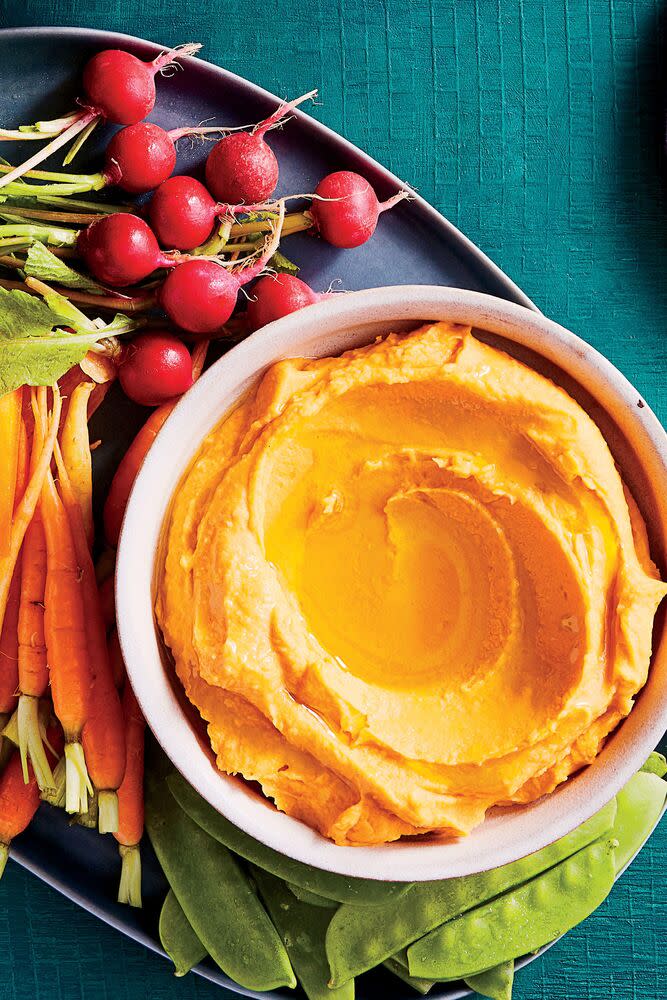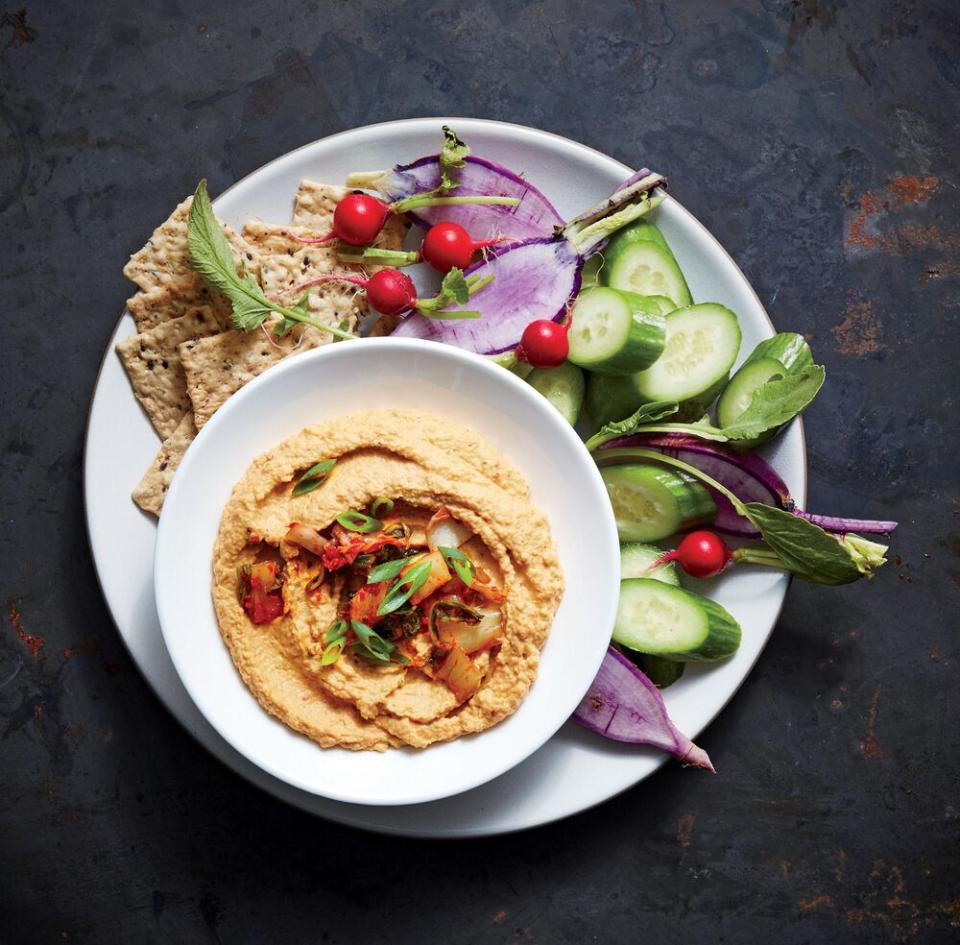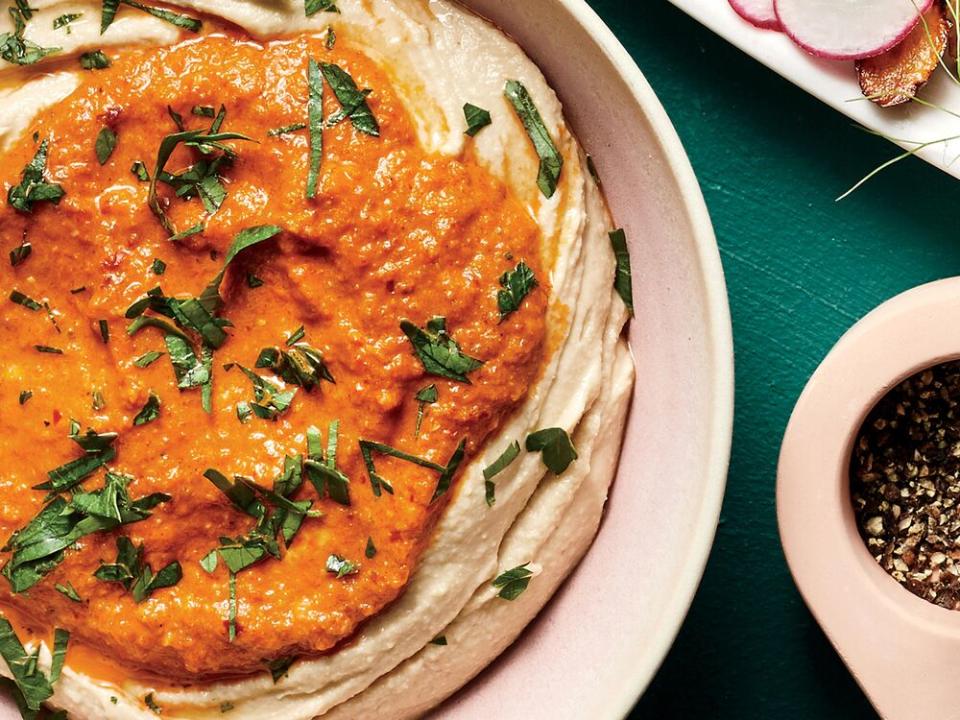How to Make Your Best Hummus Yet
There’s a multitude of reasons that hummus—traditionally, a delicious puree of chickpeas, oil, tahini, and spices—has been a celebrated dish in Egypt and other Middle Eastern countries since the 13th century. Besides being incredibly tasty, the hearty dip is filling, easy to make, and even easier to share—especially if you’ve taken the time to whip up a particularly big batch. Hummus is also fairly cheap to make; dried chickpeas don’t cost that much, and canned chickpeas speed the process for only a slight increase in coinage. However, if you’ve only ever bought hummus from the grocery store, particularly after the traditional dish became a widely marketed and (and, in some cases, white-washed) trend food in the US, you might have received the false impression that hummus can only be obtained at a mark-up.
If you keep a favorite brand of pre-made hummus dip on hand, then we certainly won’t judge. Still, if you haven’t made your own hummus before, then you should absolutely give it a shot (provided you have a food processor or blender). This guide includes traditional hummus recipes, as well as dips that were inspired by hummus—despite not technically meeting the definition of the dish itself. Use it to try creating your own dips at home, or to find a little inspiration for adding new flavors to your favorite hummus recipe.

Step One: Choose Your Base
Get the Recipes: Israeli-Style Hummus, Creamy Tahini Hummus, Roasted Sweet Potato Hummus, Our Favorite Hummus, Cauliflower Hummus, Red Bean Hummus, Black-Eyed Pea Hummus, Split Pea Hummus, Pumpkin Hummus, Black Bean Hummus with Queso Fresco, Smoky Red Lentil Hummus, Boiled Peanut Hummus, Carrot Hummus, Edamame Hummus
Hummus is a fairly straightforward dish, so creating a great base is the most important step. If making traditional hummus, you’ll first want to decide whether you want to use dried chickpeas or canned. Dried will take more time, as you’ll need to soak them overnight and then boil the chickpeas to soften them. However, dried chickpeas are often less expensive to buy, especially in bulk, and rehydrating your own chickpeas allows you to add ingredients like baking soda during the boiling process, which will help you achieve a smoother texture later when you’re ready to puree. Many also believe dried legumes to have a better flavor than their canned counterparts. Still, going with canned chickpeas will allow you to skip rehydration while still allowing for a creamy and delicious finished product. Make sure to drain your canned chickpeas first, if you decide to go that route.
Once you’ve either soaked your dried chickpeas (or opened a can), add your chickpeas, along with a couple of tablespoons of cold water, to a food processor. At this point, if you’re a fan of tahini, you can add a combo of tahini, minced garlic and lemon juice, as explained in the Israeli-Style Hummus recipe above. Process your hummus until it’s extremely smooth, adding any additional spices or flavorings as you blend. Place your hummus in a storage container or covered bowl, and refrigerate for at least two hours before serving. The dish should keep in the fridge for a few days, if you don’t consume it before then.
Since becoming popular in the U.S., several hummus-inspired recipes have been created. These recipes are made with alternatives to chickpeas, like red lentils, boiled peanuts or even cauliflower. While not technically hummus, these dishes may still please hummus lovers, so we’ve included them in the listings above. If you’re looking for ways to flavor your hummus beyond tahini and olive oil, without using an alternative to chickpeas, move forward to step two.

Step Two: Choose Your Add-Ins
Get the Recipes: Cumin Curried Hummus, Sumac Hummus, Creamy Hummus with Spiced Ground Beef, Roasted Tomato Hummus with Pecorino and Thyme, Garlic and Sun-Dried Tomato Hummus, Cashew-Lime Cilantro Hummus, Baba Gha-Hummus, Chestnut Hummus, Peanut Butter Hummus, Roasted Sweet Potato Hummus, Hazelnut Hummus, Roasted Red Pepper Hummus, Kalamata Hummus
Now that you have your base made up, you’ll want to consider whether there’s any additional flavorings or mix-ins you’d like to add (beyond tahini, garlic or lemon, if you added those already). As with other dips, the options for delicious mix-ins are seemingly limitless! Roasted vegetables, like tomatoes or red peppers, are classic options, but you can also experiment with adding less expected flavoring elements (like peanut butter or even ground meats) to your hummus. Depending on the size of your add-ins, you can either pulse your mixture a couple more times in the processor to blend in the new flavors, or you can stir them in by hand. Always feel free to experiment to figure out what textures work best for you.

Step Three: Top and Serve
Get the Recipes: Creamed Spinach Hummus Dip, Beet Hummus with Blue Cheese and Walnuts, Hummus with Raspberry Vinegar, Harissa-Spiked Hummus, Kimchi-Sesame Hummus
Mixing in other spices and ingredients is a fantastic (and easy) way to punch up hummus, but topping the dish with complimentary ingredients is also a great way to go— especially to amp up the presentation. If you’re serving a crowd of dip lovers you could try topping hummus with a different kind of dip altogether, as seen in the creamed spinach hummus dip. You could also pile a featured topping in the center of your hummus, allowing guests to sample more or less of the ingredient as they choose. This can work especially well for strong ingredients, as seen in the Harissa-Spiked Hummus above. Of course, if you’d rather go with something simple and classic, you can simply add a drizzle olive oil, additional tahini, or a sprinkling of spices to your finished dip and dig in preferably with a supply of warm, fresh pita on hand.
Additional Hummus Styles
%image1
How to Use Hummus in Sandwiches and Wraps
Get the Recipes: Grilled Veggie and Hummus Wraps, Mini Lamb Pitas with Minted Pea Hummus, Spinach Hummus and Bell Pepper Wraps, Hummus Zucchini English Muffin, Open-Faced Hummus Sandwiches, Hummus and Turkey Pinwheel Sandwiches, Hummus Veggie Sandwich on Whole Grain, Israeli Roasted Eggplant Hummus and Pickle Sandwiches
One of the best reasons to constantly keep some hummus on hand is its versatility; if you’ve only used it as a dip before, you’re limiting yourself. Try using it as a spread on your favorite sandwich or wrap, or even use it to finish off your morning bagel or muffin. Once you try it, you’ll never want to be without hummus as a savory topping option again.
How to Use Hummus on Pizzas
Get the Recipes: Ground Lamb and Hummus Pita Pizzas, Hummus and Grilled Zucchini Pizzas, Mediterranean Hummus Pizza
Since hummus makes for a great sandwich and wrap spread, it stands to reason that it would also be fantastic on pizzas. For this variation, you’ll simply want to swap your usual sauce for hummus, and perhaps drizzle a bit of olive oil across complimentary toppings. Hummus could also make for a great pizza topping itself, especially dolloped onto white pizzas or those with an olive oil base.
How to Use Hummus as a Mix-In or Filling
Get the Recipes: Hummus Vinaigrette, Red Pepper Hummus in Cucumber Cups, Hummus Mashed Potatoes, Hummus and Peppadew Peppers, Hummus Deviled Eggs
Hummus can also make for a delicious filling for appetizers, like cucumber cups or deviled eggs; or it can serve as a flavorful mix-in when added in the right proportions to other sauces and dishes. Mixing hummus into other recipes may require some trial and error to get the desired texture; a relatively small amount is needed for a vinaigrette, for example, compared to mashed potatoes. With some effort, though, you can find a way to make a hummus-infused version of many of your family’s favorites.
How to Make Fritters with Hummus
Get the Recipe: Hummus and Rice Fritters
If you’re looking for a hearty way to use up some leftover hummus, then try making these hummus and rice fritters, which can be made using from-scratch ingredients or from on-hand goods, such as store-bought hummus and precooked packaged rice. Served with a salad, they’re a delicious way to enjoy your favorite dip in fried form.
How to Make Baked Hummus
Get the Recipe: Feta-Baked Hummus
Although hummus is generally served at room temperature or cold, baked hummus can be an interesting twist on the popular dish. Before baking, try adding a slow-melting cheese, like feta, for an even better finish.

